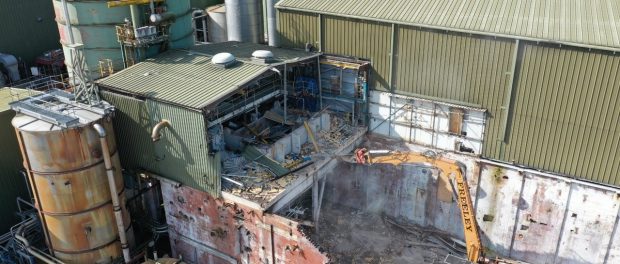COULD SUSTAINABILITY LEAD TO THE FALL OF THE DEMOLITION INDUSTRY?

Michael Freeley, Director at J Freeley, discusses the sustainability arguments surrounding demolition, how the industry is going greener, and why there will always be a need for specialist contractors.
The demolition versus retrofit debate still looms large. As the construction industry continues to seek ways to reduce its carbon emissions, refurbishment frequently wins the sustainability argument. Demolition is often portrayed as the environmentally unfriendly option, which in time, could see the demolition market decline in a similar way to the coal industry.
But is this demise a realistic prospect and is it fair to label demolition as unsustainable?
Far from black and white
The argument in favour of refurbishment hinges on concerns about embodied carbon and the belief that demolition, combined with the redevelopment which follows, causes serious damage to the environment.
The proposed demolition of Marks & Spencer’s flagship store on Oxford Street London is a case in point. When the plans were announced, the backlash and public inquiry that followed illustrates both sides of what is often a complex argument.
M&S wants to replace a 1930s building with a 10-storey office and retail block pledging that 95% of the materials would be recovered, recycled or reused. Objectors to the scheme have called for the building to be retrofitted instead and for this type of demolition to be reconsidered to help the UK achieve its net zero objectives. The plans were blocked by former communities secretary Michael Gove, but in March 2024, the High Court quashed the Government’s refusal.
Although the true impact of this decision is not yet clear, the ruling demonstrates how important it is to evaluate a building’s lifecycle when considering the sustainability impact. To ensure a balanced judgement, the input from heritage experts and other specialists should not be underestimated either.
A greener future
Demolition, by its nature, will always have an environmental impact, but the industry has been working hard to mitigate the effects.
There has already been significant progress in terms of the recycling and reusing of demolition materials. For many years, the National Federation of Demolition Contractors (NFDC) has guided members on how to maximise the recycling, reusing and repurposing of demolition materials, including timber, steel, iron and concrete. The NFDC also encourages all members to switch to low-emission, low-carbon fuel where possible.
The next leap forward will likely come from advancements in heavy plant machinery. The major plant manufacturers, many of which are associate members of the NFDC, are working closely with contractors as part of a concerted effort to make our industry greener.
Electrically powered equipment is already in use for smaller tasks and with the right technology, we think it is only a matter of time before we see electrical heavy plant with sufficient battery life and recharging capabilities. JCB is also progressing the development of hydrogen powered machinery which could result in a significant breakthrough for our industry, bolstering its green credentials.
A continuing need
Although the demolition industry faces greater environmental scrutiny, its role remains indispensable for many projects, especially where safety is the primary concern.
Take the public sector for example, which faces the significant challenge of buildings constructed with Reinforced Autoclaved Aerated Concrete (RAAC) and / or asbestos. This is an issue not only affecting hospitals across the NHS, but schools and universities. While refurbishment may be feasible for some structures, many will inevitably require demolition.
The same principle applies to a growing number of high-rise residential buildings, which have been constructed with flammable cladding or have other serious design flaws.
The industrial sector is another area where demolition can be crucial. A considerable amount of J Freeley’s work is with clients operating in chemical and food manufacturing. The processes behind these operations are evolving rapidly which can leave the associated plant obsolete. Often the most viable solution is to demolish and rebuild otherwise the building will be left to deteriorate.
More complex refurbishment projects will create opportunities for demolition contractors too. These often require specialist skills for tasks such as temporary works and retaining facades. J Freeley has been involved in several projects of this nature including the listed NHS building, Cobbett House, in Manchester. This saw our team carry out internal demolition works, including the installation of a complex propping system to load bearing walls.
Adapting to change
Looking ahead, the question whether to demolish or not shows no signs of going away. But this shouldn’t be seen as bad news for our industry. Demolition contractors’ skills and adaptability will continue to play a vital role in managing and modernising the built environment. These qualities combined with ongoing efforts to adopt greener practices, will ensure the demolition industry remains strong and can contribute to sustainable development now and in the future.

